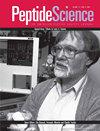Insights Into Benzothiazolyl‐Coupled Azetidinone Moieties Toward EGFR Binding and Stability Analysis—Evidence From Molecular Docking and Dynamics Simulation
IF 1.7
4区 生物学
Q4 BIOCHEMISTRY & MOLECULAR BIOLOGY
引用次数: 0
Abstract
Breast cancer, a formidable threat to women's health, mainly manifests in the HER2 subtype, affecting approximately one in five women. Thus, this study endeavors to pioneer novel approaches by exploring the efficacy of benzothiazole‐coupled azetidinone derivatives against EGFR. We aimed to elucidate their potential by employing a comprehensive array of in silico methodologies, including molecular docking, pharmacokinetics profiling, pharmacophore mapping, molecular dynamic simulations, and MMPBSA analysis. Remarkably, our results demonstrate that our designed molecules adhere to Lipinski's rule and comply with essential physiochemical and druggable properties, affirming the promise of these compounds. Ligand MS60 emerges as a lead, showcasing the most substantial interaction with the EGFR receptor, underscored by its impressive docking score of −8.199 kcal/mol. Furthermore, molecular dynamics simulations conducted via GROMACS corroborate the stability of the MS60‐EGFR complex, portraying minimal fluctuations. This assertion is further validated through MMPBSA, PCA analysis, DCCM, and FEL studies, underscoring the robustness of our findings. We have designed the pharmacophore model to unravel critical steric and electronic attributes essential for effective supramolecular interactions with the EGFR receptor. Notably, the presence of the R10, R11, and A4 groups within the ligands underscores their pivotal role in eliciting pharmacological activity, offering valuable insights for further exploration and development.苯并噻唑基偶氮杂环丁酮分子与表皮生长因子受体的结合及稳定性分析--来自分子对接和动力学模拟的证据
乳腺癌是对妇女健康的一种巨大威胁,主要表现为 HER2 亚型,大约每五名妇女中就有一人患病。因此,本研究试图通过探索苯并噻唑偶联氮杂环丁酮衍生物对表皮生长因子受体的疗效来开拓新方法。我们采用了一系列全面的硅学方法,包括分子对接、药代动力学分析、药效图谱、分子动力学模拟和 MMPBSA 分析,旨在阐明这些衍生物的潜力。值得注意的是,我们的研究结果表明,我们设计的分子符合利宾斯基规则,并符合基本的生理化学性质和可药用性质,从而肯定了这些化合物的前景。配体 MS60 是一种先导化合物,它与表皮生长因子受体的相互作用最为显著,其令人印象深刻的对接得分为 -8.199 kcal/mol。此外,通过 GROMACS 进行的分子动力学模拟证实了 MS60-EGFR 复合物的稳定性,其波动极小。这一论断通过 MMPBSA、PCA 分析、DCCM 和 FEL 研究得到了进一步验证,突出了我们研究结果的稳健性。我们设计了药理模型来揭示与表皮生长因子受体进行有效超分子相互作用所必需的关键立体和电子属性。值得注意的是,配体中存在的 R10、R11 和 A4 基团强调了它们在激发药理活性方面的关键作用,为进一步的探索和开发提供了宝贵的见解。
本文章由计算机程序翻译,如有差异,请以英文原文为准。
求助全文
约1分钟内获得全文
求助全文
来源期刊

Peptide Science
Biochemistry, Genetics and Molecular Biology-Biophysics
CiteScore
5.20
自引率
4.20%
发文量
36
期刊介绍:
The aim of Peptide Science is to publish significant original research papers and up-to-date reviews covering the entire field of peptide research. Peptide Science provides a forum for papers exploring all aspects of peptide synthesis, materials, structure and bioactivity, including the use of peptides in exploring protein functions and protein-protein interactions. By incorporating both experimental and theoretical studies across the whole spectrum of peptide science, the journal serves the interdisciplinary biochemical, biomaterials, biophysical and biomedical research communities.
Peptide Science is the official journal of the American Peptide Society.
 求助内容:
求助内容: 应助结果提醒方式:
应助结果提醒方式:


